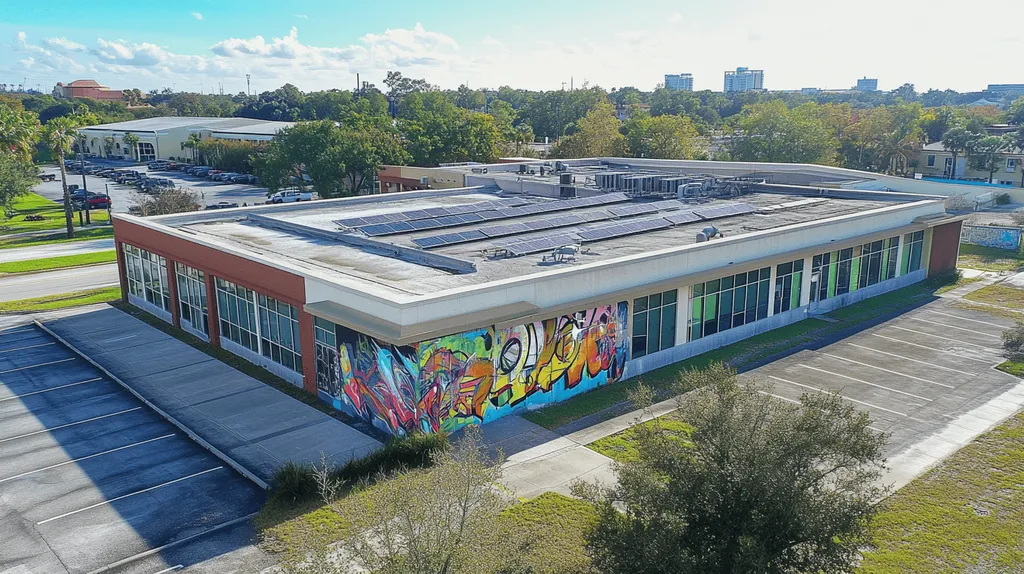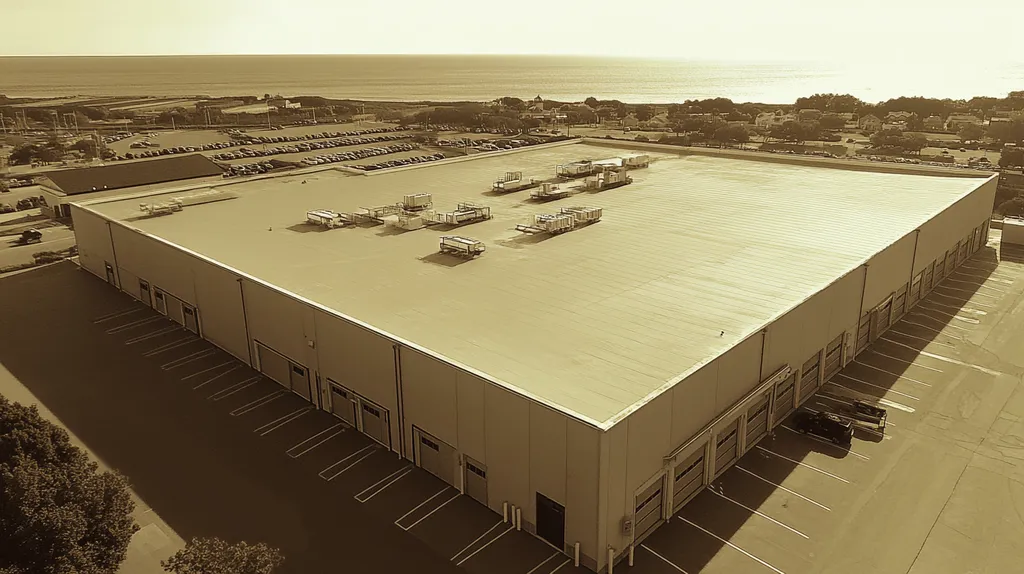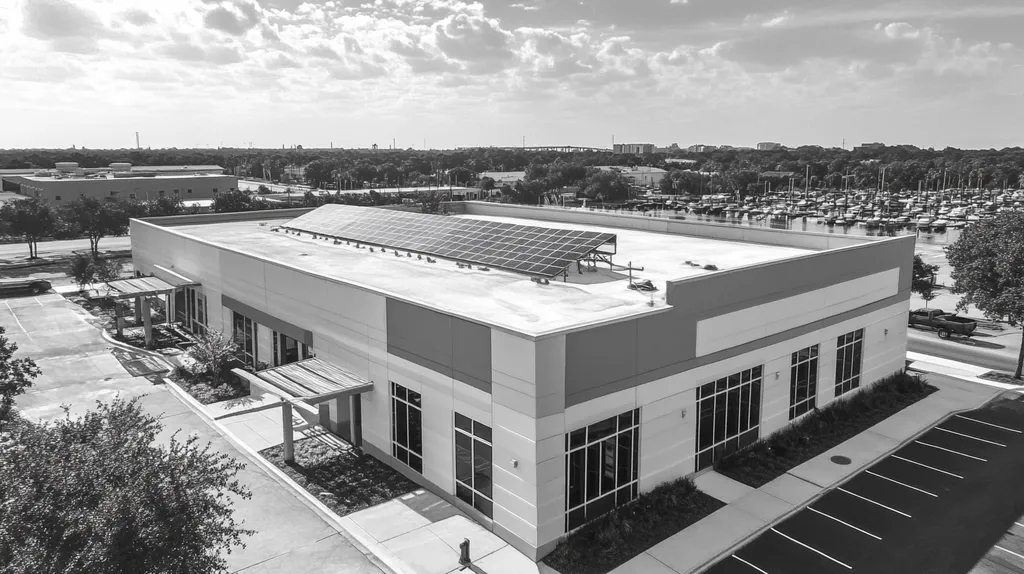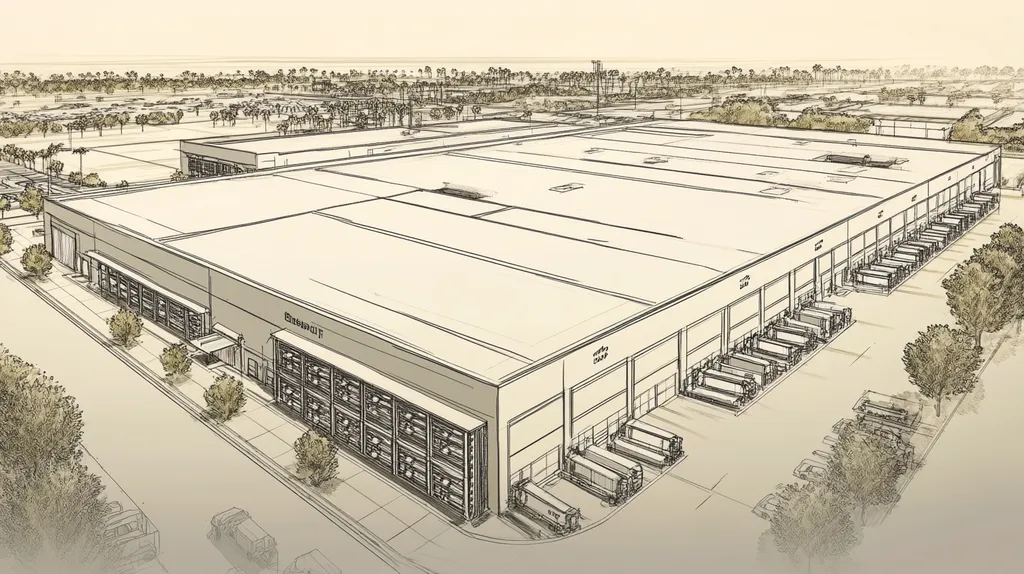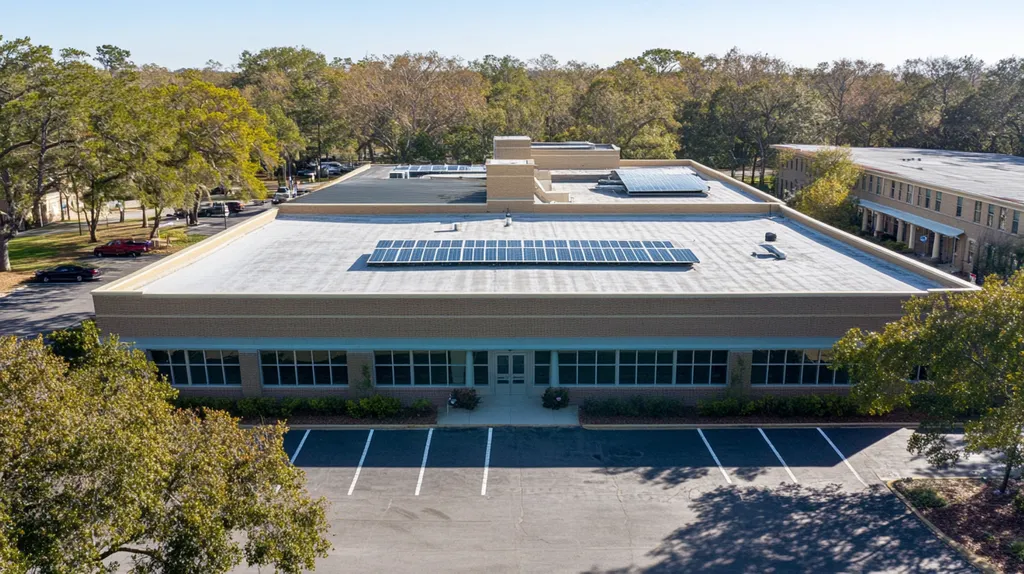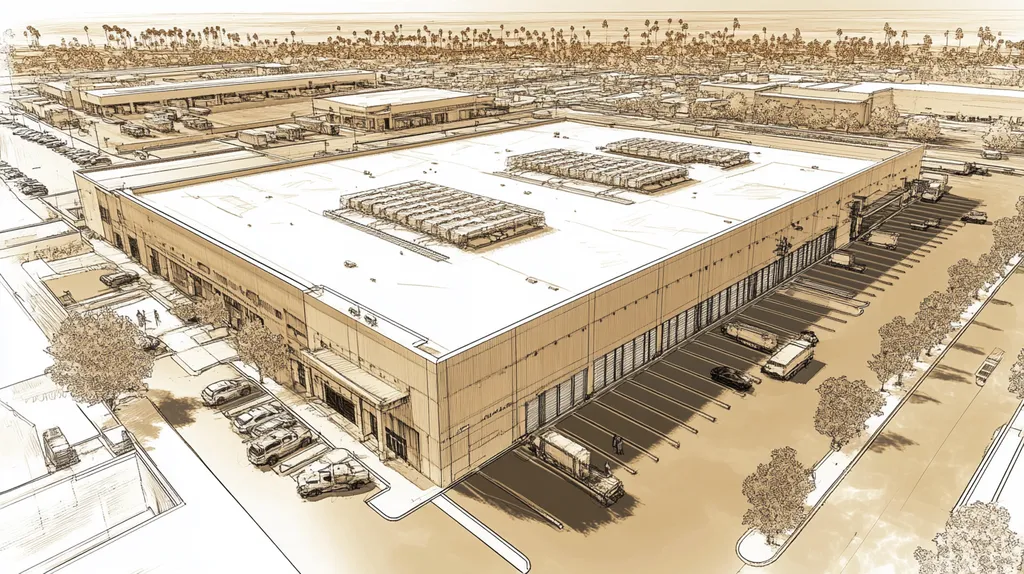Inadequate expansion joint design and installation contribute to over 30% of commercial roof failures, resulting in millions in repair costs annually across North America. These critical components directly impact the performance and longevity of roof coating systems.
As buildings naturally expand, contract, and settle, expansion joints play a vital role in preventing coating deterioration and maintaining waterproof integrity. Without proper attention to these essential elements, even premium roof coatings can fail prematurely.
This comprehensive guide examines the crucial relationship between expansion joints and coating performance, providing property owners and facility managers with actionable insights for optimizing their roofing investments.
SECTION 1: THE BASICS EXPLAINED
Understanding the role of expansion joints is vital for optimizing commercial roofing systems. Ignoring these crucial components can lead to significant repair costs and increased maintenance demands. Buildings that fail to recognize the importance of expansion joints may experience compromised roof coating performance along with a heightened risk of leaks. This section will clarify what expansion joints are, why they are essential for your building’s roofing integrity, and how they function effectively.
What It Is (In Plain Language)
Expansion joints are strategic gaps in roofing systems designed to allow for building movement. They enable roofing materials to expand and contract due to temperature changes and natural settling over time. Essentially, these joints act as a protective buffer, helping to prevent cracks and distortions that could harm the roof.
Typically located in larger commercial exteriors, expansion joints are crucial in areas where structural movement is observed. For example, they are often found at junctions between different building materials or in intersections where the roof changes direction.
A solid understanding of expansion joints provides property owners with insights into how their roofing systems manage stress. When installed correctly, these joints work in tandem with commercial roof coatings, ultimately prolonging the lifespan of the roofing system.
Why It Matters (To Your Building)
Inattention to expansion joints can yield severe consequences for any commercial building. A neglected expansion joint can lead to water leaks, causing significant water damage and interruptions to business operations. This can have a direct and detrimental impact on a company’s financial health.
When leaks occur due to joint performance issues, repair costs can quickly escalate. Property owners may find themselves facing not only costly repairs but also potential revenue loss due to halted business activities stemming from water damage.
Additionally, downplaying the need for expansion joints may introduce complications throughout the roofing system. Roof coatings, designed to shield and enhance performance, are likely to fail prematurely without the support of properly functioning joints.
How It Works
Expansion joints accommodate the movement of building structures effectively. As temperatures vary, roofing materials naturally expand or contract, and these joints provide necessary allowances without causing damage to the roofing system. When maintained properly, they play an essential role in ensuring the longevity and integrity of roofing materials.
During installation, it is crucial for contractors to ensure that each joint is adequately sealed and positioned. This prevents potential water ingress and significantly supports the overall performance of roof coatings. When properly integrated, these joints work seamlessly with the roof to distribute stress evenly.
A well-designed expansion joint system can significantly enhance the durability of roof coatings, ensuring their effective performance despite environmental changes. By maintaining properly functioning joints, property owners can protect their investments and mitigate the risks associated with roofing failure.
SECTION 2: PRACTICAL APPLICATIONS
Understanding the practical applications of expansion joints is not just beneficial; it is essential for preserving the integrity of commercial roof coatings. Neglecting these critical components can result in substantial water intrusion and damage, affecting both the structure and the bottom line. Alarmingly, the National Roofing Contractors Association cites that over 30% of roof failures stem from inadequate joint detailing. Knowing when and how to effectively implement expansion joints can significantly boost the overall functionality and longevity of roofing systems.
Common Uses & Examples
Expansion joints play a pivotal role across various roofing environments, particularly where movement is anticipated. Consider a large manufacturing facility with vast, flat roofs; here, expansion joints are vital for accommodating thermal expansion and contraction. This strategic implementation allows for controlled movements, preventing excessive stress on roofing materials.
Similarly, buildings with multiple roof sections benefit greatly from expansion joints. They act as a flexible buffer between different areas, adjusting to shifting loads and mitigating the risk of cracks. Parking garages also utilize these joints to manage the heavy vehicular traffic, ensuring the roofing system remains watertight and durable.
Schools and hospitals, which frequently experience significant temperature changes across expansive roofs, also gain from appropriately placed expansion joints. By effectively managing these thermal fluctuations, the risk of structural damage is decreased, thereby extending the roof’s life.
Furthermore, the surge in green roofing systems underscores the importance of incorporating expansion joints. Given the additional weight and moisture retention from vegetation, these joints are essential for maintaining stability and optimizing performance, ultimately supporting sustainability goals.
When You Need It Most
Identifying the right moments to implement expansion joints is vital for the roof’s peak performance. Particularly in climates with extreme temperature swings, these joints become necessary to manage the subsequent expansion and contraction of materials. In regions with hot summers and cold winters, failure to account for these shifts can result in serious roof damage.
Moreover, buildings undergoing renovations or structural changes must reassess their need for expansion joints. For example, the installation of new HVAC systems or modifications to roof layouts may necessitate a reevaluation of pre-existing joint placements. This proactive stance helps avert costly repairs and enhances the roof’s longevity.
High-traffic areas, such as shopping malls and industrial parks, necessitate careful consideration of expansion joint placement as well. Continuous heavy loads can magnify movement within the structure, making these joints crucial in maintaining overall integrity. Ignoring such considerations could lead to severe, long-term damage.
Additionally, buildings located near seismic zones should prioritize the installation of expansion joints. These components allow roofs to withstand the unique stresses associated with seismic events, safeguarding both the roofing materials and the overall structure. Neglecting this need could result in catastrophic failures, reinforcing their essential role.
Interactions With Other Systems
The interplay between expansion joints and other roofing systems is vital for optimal performance. When properly designed and installed, these joints work in unison with waterproofing membranes, enhancing the overall reliability of the roofing system. Conversely, misalignment or insufficient detailing can lead to leaks that significantly undermine the roof’s effectiveness.
Expansion joints also need to coordinate efficiently with drainage systems. Poor joint placement can obstruct drainage, leading to stagnant water accumulation that increases the risk of deterioration. Ensuring unobstructed water flow around these joints is essential for long-term durability.
Another critical interaction occurs with insulation systems. Adequate joint detailing can bolster thermal performance by minimizing air infiltration and maintaining stable indoor temperatures. This enhances energy efficiency, contributing to the overall comfort and operational cost-effectiveness within commercial spaces.
Finally, integrating expansion joints into routine maintenance protocols is essential. Regular inspections help spot wear and tear or any signs of potential failure early on. Addressing these issues swiftly can help prevent extensive repairs and prolong the lifespan of roofing systems.
SECTION 3: KEY TERMINOLOGY DECODED
Grasping the terminology linked to expansion joints is essential for enhancing commercial roof performance. Misunderstandings can lead to improper installation or maintenance, potentially costing property owners thousands in repairs. For example, neglecting differential movement can trigger early coating failures. This section demystifies crucial terms, clarifies common industry jargon, and simplifies measurement units, aiding property owners and facility managers in making informed decisions.
Essential Terms Explained
The phrase “expansion joint” signifies a structural element that facilitates movement in buildings, preventing damage to roofing materials. These joints accommodate thermal expansion, contraction, and structural shifts. Not fully comprehending their function can result in roofing systems that fail to perform as intended.
Another important term is “differential movement,” which refers to the different movements occurring between various roof sections. If not properly managed, these differences can create stress points that lead to cracks or leaks. Recognizing this concept is vital for selecting appropriate roof coatings and systems.
“Sealants” are substances used to fill gaps at expansion joints, effectively blocking water from infiltrating. The selection of an appropriate sealant greatly influences the longevity of the roof system; substandard sealants may result in leaks and further complications.
These terms lay a foundational understanding that empowers property owners to make knowledgeable choices regarding roofing systems and coatings.
Industry Jargon Translated
Terminology like “thermal expansion” and “uplift pressure” often confuses those unfamiliar with roofing dynamics. Thermal expansion is the increase in material size caused by temperature fluctuations. For roofing, this necessitates that coatings remain flexible enough to accommodate this natural change.
“Uplift pressure” refers to the forces exerted on roofs during wind events. Understanding this concept aids property managers in selecting the right coatings and membranes, ensuring protection for the roof’s structural integrity.
“Field seams” and “lap joints” designate the areas where roofing materials overlap. These connections are critical for maintaining water resistance, making it essential to understand how to manage them effectively. Poor management can lead to leaks and necessitate expensive repairs.
By demystifying this jargon, property owners and managers can confidently engage with roofing professionals, ensuring they select the optimal systems for their properties.
Measurement & Units Simplified
Measurements such as “square footage” and “mil thickness” are vital in roofing applications. Square footage assesses the roof area, which is crucial for determining material requirements and ensuring proper coating application without waste.
Mil thickness measures the coating or membrane, with one mil equaling one-thousandth of an inch. Generally, thicker coatings provide greater durability. Choosing the right thickness is key to ensuring long-term performance in varied weather conditions.
Additionally, understanding “psi” (pounds per square inch) is critical for assessing the strength and stability of roofing materials, guiding the selection of products that can withstand local environmental challenges.
Simplifying measurements empowers property owners to communicate their needs more effectively, ensuring roofing systems are accurately tailored to their unique circumstances.
SECTION 4: DECISION FACTORS
Evaluating decision factors related to expansion joints is crucial for property owners and facility managers who aim to safeguard their roofing investments. These joints substantially influence the performance of commercial roof coatings, particularly in terms of longevity and effectiveness. Failing to address these considerations can result in roof failures and costly repairs. This section delves into key aspects, including cost considerations, performance trade-offs, and lifespan and durability factors, all of which are essential for a successful roofing strategy.
Cost Considerations
Cost frequently emerges as a primary concern for property owners assessing roofing options. While initial investments in high-quality roof coatings that accommodate expansion joint movement may seem higher, they can lead to significant long-term savings through reduced maintenance costs. Neglecting potential damage from inadequately bonded expansion joints may lead to expensive repairs down the line.
Prioritizing durable materials is essential. Coatings designed to handle temperature-induced expansion and contraction can lower lifecycle costs significantly. Failing to recognize this can mislead property owners into assuming that cheaper alternatives are more cost-effective.
It is critical to recognize that lower upfront costs may hide ongoing repair needs. Therefore, a comprehensive cost analysis must encompass both immediate expenditures and future maintenance responsibilities. A financially sound approach involves evaluating both short-term investments and their long-term implications.
Performance Trade-offs
The interaction between expansion joints and overall roofing performance is significant. When roof coatings are applied without considering the role of expansion joints, property owners may encounter detrimental performance trade-offs. This often results in issues such as cracking or peeling, which can undermine both the appearance and functionality of the roofing system.
Critical performance metrics—such as reflectivity and UV resistance—can decline more rapidly if expansion joint movements are disregarded. Without a thorough understanding of how coatings engage with these joints, property managers risk falling short of industry performance standards, potentially leading to increased energy costs and reduced insulation efficiency.
Additionally, opting for flexible coatings specifically designed for use with expansion joints can greatly improve overall roofing performance. Careful evaluation of compatibility with these joints is essential to enhance the resilience and longevity of the roofing system.
Lifespan & Durability Factors
How expansion joints are addressed directly impacts the lifespan and durability of a roof. Coatings specifically engineered for these critical areas typically demonstrate superior durability, resisting the stress of building movement. This results in a more resilient roofing system that can endure environmental challenges such as moisture infiltration and extreme temperatures.
When expansion joints are neglected during coating application, roofs may experience expedited failures, sharply diminishing their expected lifespan. This can necessitate expensive premature replacements, incurring unplanned capital costs.
Moreover, ongoing exposure to environmental conditions can worsen vulnerabilities in the roofing system if expansion joints are inadequately maintained. Therefore, selecting appropriate coatings that bolster the durability of the entire roofing system is paramount. By ensuring proper care of expansion joints, property managers can considerably extend the service life of their commercial roofs.
SECTION 5: COMMON CHALLENGES
Failing to manage the challenges posed by expansion joints can jeopardize the performance of commercial roof coatings. Issues such as water infiltration, thermal movement, and material degradation can result when these critical components are ignored. This oversight not only leads to costly repairs but also shortens the lifespan of roofing systems, affecting a property’s overall value. Property managers must proactively identify these challenges to safeguard their investments and maintain the long-term functionality of their roofs.
Frequent Problems & Solutions
One prevalent issue with expansion joints is improper installation. Misalignment can create gaps that allow water infiltration, leading to leaks inside the building. To mitigate this risk, regular inspections are crucial to verify that installations meet industry standards.
Another common challenge is the deterioration of joint materials due to environmental stressors. Over time, these materials can become brittle and lose their sealing capability. Implementing a routine maintenance schedule and opting for high-quality materials can prevent premature failure, extending the joints’ service life.
Temperature variations can cause expansion joints to contract and expand excessively, resulting in cracks in roof coatings. Using flexible sealing materials specifically designed to handle thermal movement can significantly alleviate this issue.
In summary, prioritizing installation quality, selecting durable materials, and managing temperature fluctuations are essential strategies to tackle common problems associated with expansion joints and maintain effective commercial roof coatings.
Warning Signs To Watch For
Property managers should be alert to several warning indicators that point to potential expansion joint issues. Visible water stains or damp patches on ceilings or walls beneath the roof often signal leaks originating from faulty joints.
Cracks or separations at the expansion joints themselves serve as another critical warning sign. These fissures can indicate material fatigue or thermal movement problems that demand immediate intervention. Early detection can help prevent extensive damage.
Monitoring the performance of roof coatings is also vital. If the coating shows signs of bubbling, lifting, or deterioration near expansion joints, it may suggest underlying concerns needing attention. Conducting routine visual inspections can help catch these warning signs before they escalate.
Lastly, mold or mildew around joint areas can indicate trapped moisture and compromised sealing integrity. Being attentive to these signs enables timely interventions, thereby preserving the roof’s overall health.
Preventative Approaches
Proactive maintenance is essential for addressing challenges linked to expansion joints. Establishing a regular inspection schedule allows property managers to identify potential issues before they worsen. Professional evaluations should occur at least twice a year, concentrating on joint conditions.
Utilizing high-performance sealants during the initial installation can significantly enhance the longevity of expansion joints. These advanced materials are designed to withstand environmental stresses and provide effective waterproofing.
Training personnel to recognize signs of joint deterioration can also improve preventative measures. Regular workshops can empower facility managers and maintenance teams with the skills needed to monitor conditions effectively.
Finally, creating a maintenance budget that includes the treatment of expansion joints prepares property owners for future challenges. Allocating resources for necessary repairs and upgrades can lead to significant cost savings by preventing severe damage down the line.
SECTION 6: NEXT STEPS & RESOURCES
Aligning the performance of commercial roof coatings with effective expansion joint management is crucial. Failure to address these integral components can lead to significant risks, including costly leaks and increased maintenance burdens. By asking the right questions, adhering to established industry standards, and exploring educational resources, property owners and facility managers can make informed decisions that enhance the longevity and integrity of their roofing systems.
Questions To Ask Providers
When engaging with roofing contractors, property owners should focus on critical inquiries about expansion joints. Questions regarding the choice of materials are imperative, as varying materials can substantially influence durability and flexibility. Additionally, understanding how a contractor intends to incorporate joints into the overall roofing design reflects their expertise and knowledge.
Property owners should also inquire about recommended maintenance strategies for these joints. Well-planned maintenance can significantly mitigate issues and extend the lifespan of the roof. Moreover, clarifying warranty terms related to expansion joints is essential to ensure that future performance is adequately covered.
Lastly, asking about the contractor’s experience with similar roofing systems, along with requests for case studies or references, can provide insights into their proven track record and efficacy in effectively managing expansion joints.
Industry Standards & Guidelines
Familiarizing oneself with industry standards is crucial for property owners aiming to optimize their roofing systems. Organizations such as the National Roofing Contractors Association (NRCA) and the American Society for Testing and Materials (ASTM) offer guidelines essential for informed decision-making.
Specifications concerning expansion joints cover material properties, installation procedures, and maintenance practices. Understanding these standards allows property owners to make smarter choices, emphasizing the importance of proper installation for long-term building performance.
Additionally, property owners must consider local building codes and climate conditions that may impact expansion joint performance. Adaptation to these factors ensures compliance with regional regulations, enhancing safety and effectiveness in roofing solutions.
Further Learning Simplified
For those interested in expanding their knowledge about expansion joints and roof coatings, numerous resources are available. Online courses and webinars offered by roofing organizations can deliver valuable insights into best practices for managing expansion joints and optimizing roof functionality.
Industry publications and trade magazines often present articles focusing on current research and innovations in roofing. Subscribing to these resources can help property owners and facility managers remain informed about the latest advancements.
Networking with professionals at industry events also fosters knowledge sharing and collaboration. Engaging with peers promotes a better understanding of common challenges and successful strategies related to managing expansion joints in roofing systems.
The Bottom Line
With over 30% of commercial roof failures stemming from expansion joint issues, property owners cannot afford to overlook these critical components when implementing roof coating systems.
The direct relationship between expansion joints and coating performance demands careful attention to material selection, installation procedures, and ongoing maintenance protocols.
Industry standards continue to evolve as building technologies advance, requiring facility managers to stay informed about best practices and emerging solutions.
By prioritizing proper expansion joint design and maintenance, property owners can significantly extend coating lifespans while avoiding costly repairs and business disruptions.
The future of commercial roofing depends on integrating these essential components effectively, making informed decisions about expansion joints more critical than ever for protecting valuable real estate investments.
FREQUENTLY ASKED QUESTIONS
Q. What are expansion joints in commercial roof systems?
A. Expansion joints are strategic gaps that allow for movement in roofing materials, accommodating expansion and contraction due to temperature changes. Their role is crucial in preventing cracks and ensuring a roof’s structural integrity. Properly functioning expansion joints help extend the lifespan of commercial roof coatings.
Q. How do expansion joints affect performance of industrial roofs?
A. Properly placed expansion joints are critical for maintaining the integrity of industrial roofs. They facilitate movement, reducing stress on roofing materials and preventing damage. Neglecting these components may lead to leaks, compromising both the structure and the efficacy of the roof’s protective coatings.
Q. When should expansion joints be installed on a commercial roof?
A. Expansion joints should be installed during the initial construction phase, particularly in regions experiencing extreme temperature fluctuations. It is also essential to reevaluate their placement during renovations, especially when structural modifications or new installations occur. Proper timing ensures optimal performance and longevity.
Q. What common materials are used for expansion joints in commercial roofing?
A. Common materials for expansion joints include rubber, neoprene, and thermoplastic sheets, which offer flexibility and durability. Waterproof sealants are also integral to ensure effective moisture barriers. Selecting the right materials is essential for maintaining the integrity of roofing systems and enhancing their lifespan.
Q. What are the warning signs of failing expansion joints?
A. Key warning signs include visible water stains on ceilings, cracks around the joints, and deteriorating roof coatings. Noticing mold around joint areas can signal moisture issues. Early detection allows property managers to address problems before they escalate, safeguarding roof integrity.
Q. How can maintenance prevent issues with expansion joints?
A. Regular maintenance, including inspections and timely repairs, can prevent expansion joint failures. Employing high-performance sealants during installations boosts durability, while training staff to recognize issues promotes proactive care. Establishing a maintenance budget for future repairs enhances long-term roof performance and reliability.
Q. What educational resources exist for expansion joints in roofing?
A. Numerous resources available include online courses, industry publications, and webinars focused on roofing best practices. Engaging with local roofing associations and attending industry events can enhance understanding of expansion joints. Networking with professionals provides valuable insights into effective management strategies and challenges.

